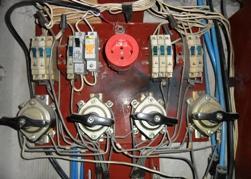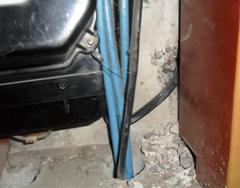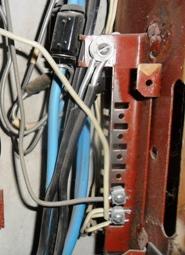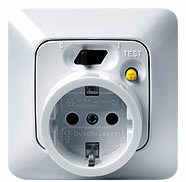Categories: Controversial issues, Electrician at home, Automata and RCD, Safety precautions
Number of views: 202397
Comments on the article: 93
RCD in two-wire: to put or not to put?
 Electrical engineering is an exact science and here, unlike such ephemeral areas of human activity as, for example, design, there are clearly documented norms and rules (PUE, GOSTs, instructions), and not just “like” or “don't like”. Yes, the PUE is “the bible of an electrician” and the formidable phrase “read in the PUE” speaks of the importance, pumpability and great seriousness of those who said it.
Electrical engineering is an exact science and here, unlike such ephemeral areas of human activity as, for example, design, there are clearly documented norms and rules (PUE, GOSTs, instructions), and not just “like” or “don't like”. Yes, the PUE is “the bible of an electrician” and the formidable phrase “read in the PUE” speaks of the importance, pumpability and great seriousness of those who said it.
But it turns out in life is always much more complicated everything is arranged than it is written even in the wisest books and these books can be interpreted in different ways. Especially heated discussions among electricians in electrical forums raise questions ground related electrical installations and installation residual current circuit breakers (RCD).
It so happened that in our time in everyday life there are two grounding systems TN-C and TN-C-S. The first grounding system, in the vast majority of cases, is present in houses of the old construction, the second - in the new residential sector and in private cottages. These grounding systems differ in the number of conductors.
 System TN-C usually has 4 wires in three-phase execution (three phases and zero) and 2 wires in single-phase (phase and zero - PEN conductor) i.e. with such a system, with a four-wire connection, the zero and the working and protective are combined, and in the two-wire connection there is no grounding conductor.
System TN-C usually has 4 wires in three-phase execution (three phases and zero) and 2 wires in single-phase (phase and zero - PEN conductor) i.e. with such a system, with a four-wire connection, the zero and the working and protective are combined, and in the two-wire connection there is no grounding conductor.
In the TN-C-S system, zero is most often divided at the entrance to the building. If zero is divided in a transformer substation, then this is already a system TN-Sbut such things are rare in real life. So, according to the TN-C-S system, from the moment of separation of the neutral wire into the working conductor (N) and protective conductor (PE) with a three-phase connection, 5 wires appear (three phases, N and PE), with single-phase three wires (phase, N, PE).
 In the future, all consumers will receive power through the system. TN-S, or, more likely, TN-C-S. But this is in the future. But what to do now, the unfortunate owner of apartments in houses with old wiring made using the TN-C system? How to protect yourself and your loved ones from electric shock? After all, it has long been recognized that the old system TN-C does not allow to fully ensure a sufficient level electrical safety. This fact was the reason for the transition to a new system. TN-S.
In the future, all consumers will receive power through the system. TN-S, or, more likely, TN-C-S. But this is in the future. But what to do now, the unfortunate owner of apartments in houses with old wiring made using the TN-C system? How to protect yourself and your loved ones from electric shock? After all, it has long been recognized that the old system TN-C does not allow to fully ensure a sufficient level electrical safety. This fact was the reason for the transition to a new system. TN-S.
Most technically competent comrades will say - put an RCD and refer to the correct regulatory documents, according to which it is highly recommended to put an RCD for everyone. Of all the known electrical protective equipment, an RCD is the only one that provides protection to a person from electric shock when directly touching one of the live parts.
Everything seems to be simple - take it and do it. But it turns out that these comrades have a well-organized opposition, which are ardent opponents of the installation of residual current circuit breakers in houses with old wiring working on the TN-C system (the so-called RCD in two-wire) And it’s not strange, this group also found confirmation in the regulatory documents, including in PUE.
In their opinion, the installation of RCDs is possible only in conjunction with the modernization of all electrical wiring with the transition system TN-C on TN-C-S. In this case, the RCD will always be triggered when the leakage current appears. Otherwise, the RCD in the system is not only harmful, but also dangerous, because in system TN-C RCD trips only at the moment of contact (leakage current flows through the human body). In addition, there is generally a very dangerous option for including a person in a circuit while touching the phase and zero. In this case, a lethal current will flow through the person, and the protective shutdown device will not work.
 Well, and most importantly, these are constant almost unreasonable blackouts of RCDs in houses with old wiring. For the operation of the RCD, a leakage current of 30 mA is sufficient, and with old wiring, such leakage current will appear regularly and affect the reliability of the apartment’s power supply.
Well, and most importantly, these are constant almost unreasonable blackouts of RCDs in houses with old wiring. For the operation of the RCD, a leakage current of 30 mA is sufficient, and with old wiring, such leakage current will appear regularly and affect the reliability of the apartment’s power supply.
what what to do in this case? Whom to listen to? After all, it’s not so easy to transfer your apartment to a three-wire apartment yourself. It is impossible to split the zero wires in the floor shield (in the case of "burning off zero" this threatens you with big problems), but you need to redo the entire riser. Here, as always lucky only to owners of their own cottages. Do whatever you want, most importantly by the rules and hands of good specialists.
So all the same, put an RCD or not in a two-wire? How with all my desire to start living under the PUE?
I believe that in any case, an RCD should be set. It will definitely not be completely useless and will fulfill its function at the right time while saving your health, and possibly life. By installing an UZO, we increase the degree of electrical safety of our apartment. Even taking into account all the shortcomings of the RCD when installing it in a two-wire system, with a residual current device, you will certainly be calmer than without it.
And what if, with the old wiring, the RCD will constantly de-energize the apartment? It seems to me that there is a way out of this difficult situation.
 In nature, there are such animals as UZO outlet, i.e. They are intended for installation in each specific outlet (RCD-plug, RCD-adapter). Exist and ready-made sockets with built-in RCD. The use of such RCDs solves the problem of continuous tripping and shutdowns of the entire apartment with old poor wiring and at the same time provides a fairly good level of electrical safety.
In nature, there are such animals as UZO outlet, i.e. They are intended for installation in each specific outlet (RCD-plug, RCD-adapter). Exist and ready-made sockets with built-in RCD. The use of such RCDs solves the problem of continuous tripping and shutdowns of the entire apartment with old poor wiring and at the same time provides a fairly good level of electrical safety.
Such RCDs can be used to protect individual electrical circuits from electric shock. It is especially advisable to install such protective rosette devices in rooms that are dangerous from the point of view of electric shock, such as kitchens, on a washing machine, in children's rooms. And most importantly, all types of electrical networks are suitable for connecting these types of RCDs - TN-C, TN-S and TN-C-S (This fact is noted in the instructions for the RCD outlet).
You don’t have to climb into floor electrical panel, just change the outlet. Well, then it remains to wait until the organization operating the house finally gets down to modernizing the wiring in the riser of your staircase.
What do you think about this?
See also at i.electricianexp.com
:
